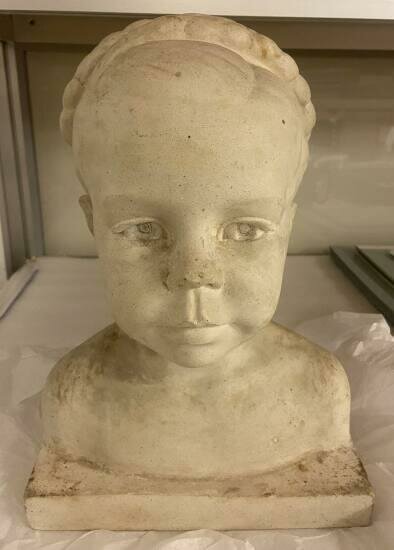Sitting still for Augusta Savage's sculpture
Guest shares fond memories at artist's 132nd Birthday Gala
jack@claytodayonline.com
FLEMING ISLAND – The Augusta Savage 132nd Birthday Gala featured a special guest. Dr. Cathy Powers shared her fond memory of when the acclaimed artist, Augusta Savage, was commissioned to create her sculpture...
This item is available in full to subscribers.
Attention subscribers
To continue reading, you will need to either log in to your subscriber account, below, or purchase a new subscription.
Please log in to continueDon't have an ID?Print subscribersIf you're a print subscriber, but do not yet have an online account, click here to create one. Non-subscribersClick here to see your options for subscribing. Single day passYou also have the option of purchasing 24 hours of access, for $1.00. Click here to purchase a single day pass. |
Sitting still for Augusta Savage's sculpture
Guest shares fond memories at artist's 132nd Birthday Gala
FLEMING ISLAND – The Augusta Savage 132nd Birthday Gala featured a special guest. Dr. Cathy Powers shared her fond memory of when the acclaimed artist, Augusta Savage, was commissioned to create her sculpture.
“I am humbled to share my little slice of history,” said Powers last Saturday during the ceremony at Sacred Heart Catholic Church’s Sullivan Hall.
Powers was 7 and living in New York at the time. It was summer, and she was the only girl attending her father’s summer camp. It was during that summer her parents commissioned Savage to sculpt a bust in Powers' image and likeness.
She recounted how she curtsied for Savage when they met.
“I remember that very well,” Powers said.
She described Savage as being calm, pleasant, and serious but not severe.
“Her attention was profound. Her fingers were nimble. I remember her eyes. She would look back and forth at me and then at the block of clay. Her fingers were always moving. Her eyes were always focused.”
Powers recounted how she had to sit still for Savage. The boys at the summer camp were working on their own arts and crafts projects off to the side, which was sometimes distracting. Anytime Powers glanced away, Savage reeled her back in.
“She was always confident and respectful. She had a job to do. We hardly spoke unless it was, ‘Come back to me,’” Powers said.
She said the sculpting sessions took place over a couple of days or weeks. Her mother did her braids for her every day before the sessions. She said she could not see the finished product until the end.
“I was not allowed to look. When I first saw it, I was so impressed. She got the braids so right,” Powers said.
However, Powers thought the eyes were a bit off. She took a pencil and tried etching to correct the eyes, which furthered her disappointment. She thought her father would be furious for damaging an expensive commission, but he wasn’t.
“I thought he was going to be upset. Instead, he said, ‘Well, now you’ve added your own piece to it,’” Powers said.
She said the sculpture of 7-year-old Powers was tucked away in a closet for 70 years. She was conflicted about what to do with the bust for many years. She said it didn’t feel right to leave it on her mantle; it would be better for the whole world to see Savage's work and to learn about the scuplter's life, how Savage overcame so many barriers as a Black woman in the early 19th century.
Powers ended up donating the bust to the New York Historical Society. You can still see the etchings in the eyes today.
Augusta Savage was born in Green Cove Springs on Feb. 29, 1892. She made animals from red clay from the Clay County Brick Works. Her father was a Methodist minister who often abused her to discourage her creative interests, according to the Smithsonian American Art Museum.
“(He) almost whipped all the art out of me,” Savage once said.
Her passion waned when Savage’s family moved to West Palm Beach in 1915. Quality sculpting clay was hard to find (since leaving “Clay” County, after all). In 1919, a local potter gave Savage sculpting clay, which she used to model a group of figures that she entered at the West Palm Beach County Fair, according to the Smithsonian.
The figures received critical acclaim at the county fair, which encouraged Savage to continue pursuing her passion. She moved to New York City in the 1920s and contributed to the Harlem Renaissance, a blooming rebirth of Black art and culture.
She earned a reputation as a portrait sculptor, completing busts of prominent Black figures such as W.E.B. Du Bois and Marcus Garvey.
Savage believed in the cultural significance of art and the importance of teaching. She established the Harlem Community Art Center in 1937 and became its first director. The center was closed in 1942 when federal funds were cut during World War II.
In the twilight of her career, she taught children art in local summer camps. She continued to create commissioned sculptures, such as the one she made for Powers.
“I have created nothing really beautiful, really lasting, but if I can inspire one of these youngsters to develop the talent I know they possess, then my monument will be in their work,” Savage famously said.
While many of Savage’s greatest works have been lost or destroyed, her legacy has continued to inspire young artists at the Augusta Savage Museum & Mentoring Center.
Sponsored by the Friends of Augusta Savage Arts & Community Center, the fundraiser gala was a celebration of Savage’s legacy and the achievements of the community center, from which the proceeds will help fund.








